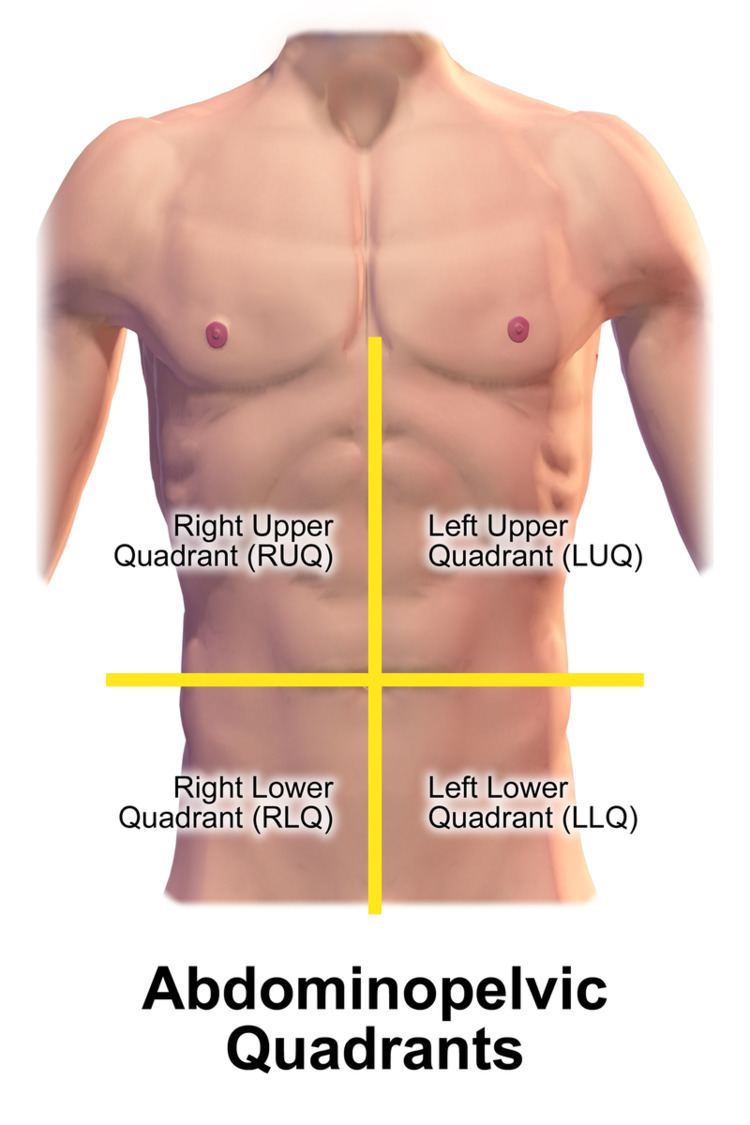The human abdomen is divided into regions by anatomists and physicians for purposes of study, diagnosis, and therapy. In the four-region scheme, four quadrants allow localisation of pain and tenderness, scars, lumps, and other items of interest, narrowing in on which organs and tissues may be involved. The quadrants are referred to as the left lower quadrant, left upper quadrant, right upper quadrant and right lower quadrant, as follows below. These terms are not used in comparative anatomy, since most other animals do not stand erect.
The left lower quadrant (LLQ) of the human abdomen is the area left of the midline and below the umbilicus. The LLQ includes the left iliac fossa and half of the left flank region. The equivalent term for animals is left posterior quadrant.
The left upper quadrant (LUQ) extends from the median plane to the left of the patient, and from the umbilical plane to the left ribcage. The equivalent term for animals is left anterior quadrant.
The right upper quadrant (RUQ) extends from the median plane to the right of the patient, and from the umbilical plane to the right ribcage. The equivalent term for animals is right anterior quadrant.
The right lower quadrant (RLQ) extends from the median plane to the right of the patient, and from the umbilical plane to the right inguinal ligament. The equivalent term for animals is right posterior quadrant.
Left lower quadrant:
Descending colon
Sigmoid colon
Left ovary and Fallopian tube
Left ureter
Left upper quadrant:
Stomach
Spleen
Left lobe of liver
Body of pancreas
Left kidney and adrenal gland
Splenic flexure of colon
Parts of transverse and descending colon
Right upper quadrant:
Liver
Gall bladder with biliary tree
Duodenum
Head of pancreas
Right kidney and adrenal gland
Hepatic flexure of colon
Right lower quadrant:
Cecum
Appendix
Ascending Colon
Right ovary and Fallopian tube
Right ureter
If abdominal pain or signs of peritonitis are localised in the LLQ, colitis, diverticulitis, ureteral colic or pain due to ovarian cysts or pelvic inflammatory disease may be suspected. Examples of tumors in the left lower quadrant include colon cancer and ovarian tumor.
The LUQ may be painful or tender in the case of intestinal malrotation. The RUQ may be painful or tender in hepatitis, cholecystitis, and peptic ulcer. The RLQ may be painful and/or tender in such conditions as appendicitis.
Children
gastroenteritis, mesenteric adenitis, Meckel's diverticulitis, intussusception, Henoch–Schönlein purpura, lobar pneumonia
Adults
regional enteritis, renal colic, perforated peptic ulcer, testicular torsion, rectus sheath hematoma, pelvic inflammatory disease, ectopic pregnancy, endometriosis, torsion/rupture of ovarian cyst, appendicitis
Elderly
diverticulitis, intestinal obstruction, colonic carcinoma, mesenteric ischemia, leaking aortic aneurysm

